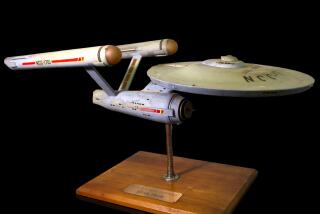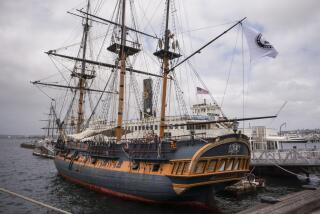Model ship collector’s obsession has docked
- Share via
HAMBURG, GERMANY — For Peter Tamm, the passion that launched a thousand ships -- and Hamburg’s newest museum along the port city’s old docks -- began with a gift from his mother in 1934.
“A 500-gross tonnage coaster from the North Sea-Baltic line,” Tamm said, rattling off specs of that first vessel in his possession.
Of course, 500 gross tons was a little too big for a 6-year-old. What Tamm’s mother gave him was an inch-long model of the cargo ship.
“Then came the second, then came the third, until I lost count,” said Tamm.
Today he has 36,000. Each and every one built to the same 1:1,250 scale -- and that’s not all.
He also has amassed thousands of photographs of ships and their crews, a flotilla of larger models and a maritime library of more than 100,000 volumes that include knot manuals and rare 17th century ship blueprints.
Now the objects of Tamm’s lifelong obsession have a new home.
In June, the cigar-puffing, 80-year-old millionaire opened the International Maritime Museum in a warehouse near the Hamburg harbor that was renovated with city funds.
Hamburg, where Tamm has lived his entire life, is a fitting home for the museum. The city is Germany’s biggest port and one of Europe’s busiest.
“Without a harbor, Hamburg wouldn’t be here at all,” Tamm said.
Tamm’s father served aboard a German submarine cruising the Mediterranean in World War I. During World War II, Tamm was a high school student in Hamburg -- a center for building German warships -- and witnessed some of the conflict’s worst destruction.
In July 1943, Allied bombs leveled much of the city and stirred up a fire that raged to nearly 1,500 degrees Fahrenheit. Some 40,000 civilians were killed in a week.
“Half of my classmates died in the bombing,” Tamm said. “I was lucky enough to survive. My entire life has been a coincidence.”
For three years after the war, Tamm and his family struggled just to find food.
“That was the worst time,” he said.
But he didn’t stop collecting. He traded German chocolate for model battleships with the Allied soldiers stationed in his city.
He stayed in Hamburg and earned a fortune, but not in the shipping trade that made the city rich.
To pay his college tuition, Tamm wrote feature stories about tankers and cargo ships arriving from exotic ports and sold them to the newspaper Hamburger Abendblatt. The paper hired him full time, and he started a climb to become a captain of the German media industry.
Tamm spent more than two decades as chief executive of Axel Springer, one of Europe’s largest publishers, with about 170 newspapers and magazines in 33 countries. That gave him the wherewithal to indulge his hobby, one carved ivory model, one faded ship’s log at a time.
The death of Axel Springer’s founder and namesake in 1985 involved Tamm in a lengthy power struggle that eventually led him to retire from the company in 1991. Retirement gave him more time to spend at auctions and estate sales and to found a ship and marine history institute.
At the new maritime museum, his collection fills nine floors -- called decks in Tamm’s ship-obsessed universe -- and traces the history of humanity’s adventures at sea.
The journey starts with a blackened dugout log -- a primitive boat, perhaps 3,000 years old, excavated near the riverside village of Geesthacht in northern Germany.
An interactive display invites visitors to try navigating with a sextant, an instrument that helps calculate a ship’s position by measuring the angle between a known celestial object and the horizon.
The next room is full of maps made by early explorers, many of which show discovered continents in comical disproportion.
Tamm collected dozens of sailor uniforms, and many are on display in floor-length glass cases next to scabbards and the gold-colored epaulets that would denote a seaman’s rank. The most comprehensive set of outfits comes from the British Navy -- Tamm speaks of the British with awe-struck admiration for their maritime accomplishments -- but a case of hats also holds fezzes worn by Muslim sailors in the Austro-Hungarian navy and white caps from seamen in Thailand.
Another room holds some of Tamm’s 15,000 ship’s menus, dating back to the 1890s. Among them are examples of what was being served aboard the Queen Mary, retired in 1967, and the Lusitania, the British liner sunk by a German submarine in 1915. That event helped create the climate for the U.S. to enter World War I, since many Americans were among the more than 1,100 passengers killed.
The museum is equal parts education center and showroom. A model cutter made of solid gold guards the entrance to a room full of sailing ships carved from ivory. Another 20 models are made entirely from pig bone. They were carved in the 18th century by bored ship’s prisoners using bones they picked out of their salted-pork rations.
During an interview at his sprawling museum office decorated with large oil paintings of Russian and German sailing ships, Tamm shuffled over to his desk to stamp out a cigar and retrieve that first model coaster ship. As he held the tiny replica and looked out the window at a forest of cranes in Hamburg’s redeveloping harbor, he said he hoped the museum would inspire a new generation to love the sea.
“I hope children will wander through the museum and be fascinated by the ships,” Tamm said. “After all these years, I know the joy of finding a passion and following it. Age has its advantages.”
More to Read
Sign up for The Wild
We’ll help you find the best places to hike, bike and run, as well as the perfect silent spots for meditation and yoga.
You may occasionally receive promotional content from the Los Angeles Times.






